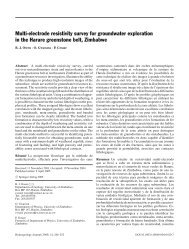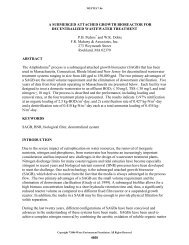Species diversity in the Florida Everglades, USA - Environmental ...
Species diversity in the Florida Everglades, USA - Environmental ...
Species diversity in the Florida Everglades, USA - Environmental ...
Create successful ePaper yourself
Turn your PDF publications into a flip-book with our unique Google optimized e-Paper software.
Aquat. Sci. Vol. 68, 2006 Overview Article 265<br />
<strong>the</strong> landscape, <strong>in</strong>clude: opossum (Didelphis virg<strong>in</strong>iana),<br />
cotton rat (Sigmodon hispidus), bobcat (Lynx rufus),<br />
white-tailed deer (Odocoileus virg<strong>in</strong>ia), and raccoon<br />
(Procyon lotor). <strong>Species</strong> that are confi ned to <strong>the</strong> east<br />
coast <strong>in</strong>clude oldfi eld mouse (Peromyscus polionotus)<br />
and <strong>Florida</strong> mouse (P. fl oridanus). Many of <strong>the</strong> land<br />
mammals are more terrestrial <strong>in</strong> <strong>the</strong>ir affi nity for habitat<br />
types and thus do not occur <strong>in</strong> great numbers throughout<br />
<strong>the</strong> wetland portions of <strong>the</strong> <strong>Everglades</strong>. A considerable<br />
number of species have divided ranges, with populations<br />
on <strong>the</strong> east and west sides of <strong>the</strong> <strong>Everglades</strong> <strong>in</strong> <strong>the</strong> more<br />
terrestrial environments. Examples <strong>in</strong>clude short-tailed<br />
shrew (Blar<strong>in</strong>a brevicauda), eastern cottontail (Sylvilagus<br />
fl oridanus), grey squirrel (Sciurus carol<strong>in</strong>ensis),<br />
sou<strong>the</strong>rn fl y<strong>in</strong>g squirrel (Glaucomys volans), cotton<br />
mouse (Peromyscus gossyp<strong>in</strong>us) and marsh rabbit (Sylvilagus<br />
palustris). The <strong>Everglades</strong> m<strong>in</strong>k (Mustela vison<br />
evergladensis) is <strong>the</strong> only mammal hav<strong>in</strong>g two well-separated<br />
disjunct populations.<br />
Table 9. Mammals of <strong>Everglades</strong> National Park.*<br />
<strong>Species</strong> Status<br />
There is only limited <strong>in</strong>formation on population<br />
trends and population ecology of most <strong>Everglades</strong> mammals.<br />
While presently <strong>the</strong>re is little or no empirical data<br />
to document population trends of most species of mammals<br />
<strong>in</strong> <strong>the</strong> <strong>Everglades</strong> bas<strong>in</strong>, it is widely speculated that<br />
several species dependent on freshwater marsh habitats<br />
have substantially decl<strong>in</strong>ed as a result of human <strong>in</strong>duced<br />
changes (Science Sub-group, 1996). Two species of pr<strong>in</strong>cipal<br />
concern are <strong>the</strong> round-tailed muskrat (Neofi ber alleni)<br />
and <strong>the</strong> river otter (Lutra canadensis). Two endangered<br />
species with habitat with<strong>in</strong> <strong>Everglades</strong> National<br />
Park are <strong>the</strong> Key Largo wood rat (Neotoma fl oridana<br />
smalli) and <strong>the</strong> Key Largo cotton mouse (Peromyscus<br />
gossyp<strong>in</strong>us allapaticola). O<strong>the</strong>r more upland species<br />
such as <strong>the</strong> three native squirrels (gray (Sciurus carol<strong>in</strong>ensis),<br />
fox (Sciurus niger), and sou<strong>the</strong>rn fl y<strong>in</strong>g (Glaucomys<br />
volans)) and <strong>the</strong> black bear (Ursus americanus fl oridanus)<br />
have become greatly reduced <strong>in</strong> numbers and<br />
range as a result of human development activities (Table<br />
Opossum (Didelphis virg<strong>in</strong>iana) Locally common<br />
Short-tailed shrew (Blar<strong>in</strong>a brevicauda) Locally common<br />
Least shrew (Cryptotis parva) Locally common<br />
Eastern mole (Scalopus aquaticus) Hypo<strong>the</strong>tical<br />
Sem<strong>in</strong>ole bat (Lasiurus sem<strong>in</strong>olus) Hypo<strong>the</strong>tical<br />
<strong>Florida</strong> yellow bat (Lasiurus <strong>in</strong>termedius) Hypo<strong>the</strong>tical<br />
Even<strong>in</strong>g bat (Nycticeius hymeralis) Hypo<strong>the</strong>tical<br />
Brazilian free-tailed bat (Tadarida brasiliensis) Hypo<strong>the</strong>tical<br />
<strong>Florida</strong> mastiff bat (Eumops glauc<strong>in</strong>us) Hypo<strong>the</strong>tical<br />
Marsh rabbit (Sylvilagus palustris) Common<br />
Eastern cottontail (Sylvilagus fl oridanus) Rare to common<br />
Gray squirrel (Sciurus carol<strong>in</strong>ensis) Rare to locally common<br />
Fox squirrel (Sciurus niger) Uncommon<br />
Sou<strong>the</strong>rn fl y<strong>in</strong>g squirrel (Glaucomys volans) Uncommon<br />
Rice rat (Oryzomys palustris) Common<br />
Cotton mouse (Peromyscus gossyp<strong>in</strong>us) Common<br />
Cotton rat (Sigmodon hispidus) Common<br />
Roundtail muskrat (Neofi ber alleni) Locally common<br />
Grey fox (Urocyon c<strong>in</strong>eroargenteus) Rare<br />
Black bear (Ursus americanus) Rare<br />
Raccoon (Procyon lotor) Common<br />
<strong>Everglades</strong> m<strong>in</strong>k (Mustela vison) Uncommon<br />
Long-tailed weasel (Mustela frenata) Hypo<strong>the</strong>tical.<br />
Eastern spotted skunk (Spirogale putorius) Hypo<strong>the</strong>tical<br />
Striped skunk (Mephitis mephitis) Rare<br />
River otter (Lutra canadensis) Uncommon.<br />
<strong>Florida</strong> pan<strong>the</strong>r (Felis concolor) Endangered subspecies (F.c.coryi).<br />
Bobcat (Lynx rufus) Common<br />
White-tailed deer (Odocoileus virg<strong>in</strong>ianus) Common<br />
N<strong>in</strong>e-banded armadillo (Dasypus novemc<strong>in</strong>ctus L<strong>in</strong>naeus) Introduced. Somewhat common<br />
Roof rat (Rattus rattus) Introduced. Uncommon<br />
House mouse (Mus musculus) Introduced. Common<br />
Norway rat (Rattus norvegicus) Introduced. Hypo<strong>the</strong>tical.<br />
Red fox (Vulpes vulpes) Introduced. Rare<br />
Coati (Nasua narica) Introduced. Rare.<br />
Domestic dog (Canis familiaris) Introduced. Rare<br />
Domestic cat (Felis domesticus) Introduced. Rare<br />
Domestic pig (Sus scrofa)<br />
* after <strong>Florida</strong> National Parks & Monuments Association (n.d.)<br />
Introduced. Rare
















